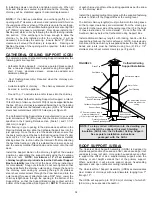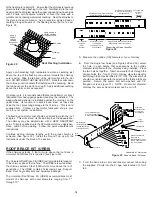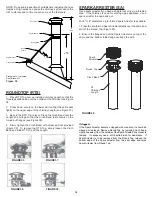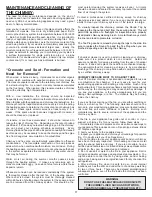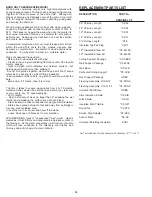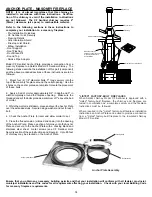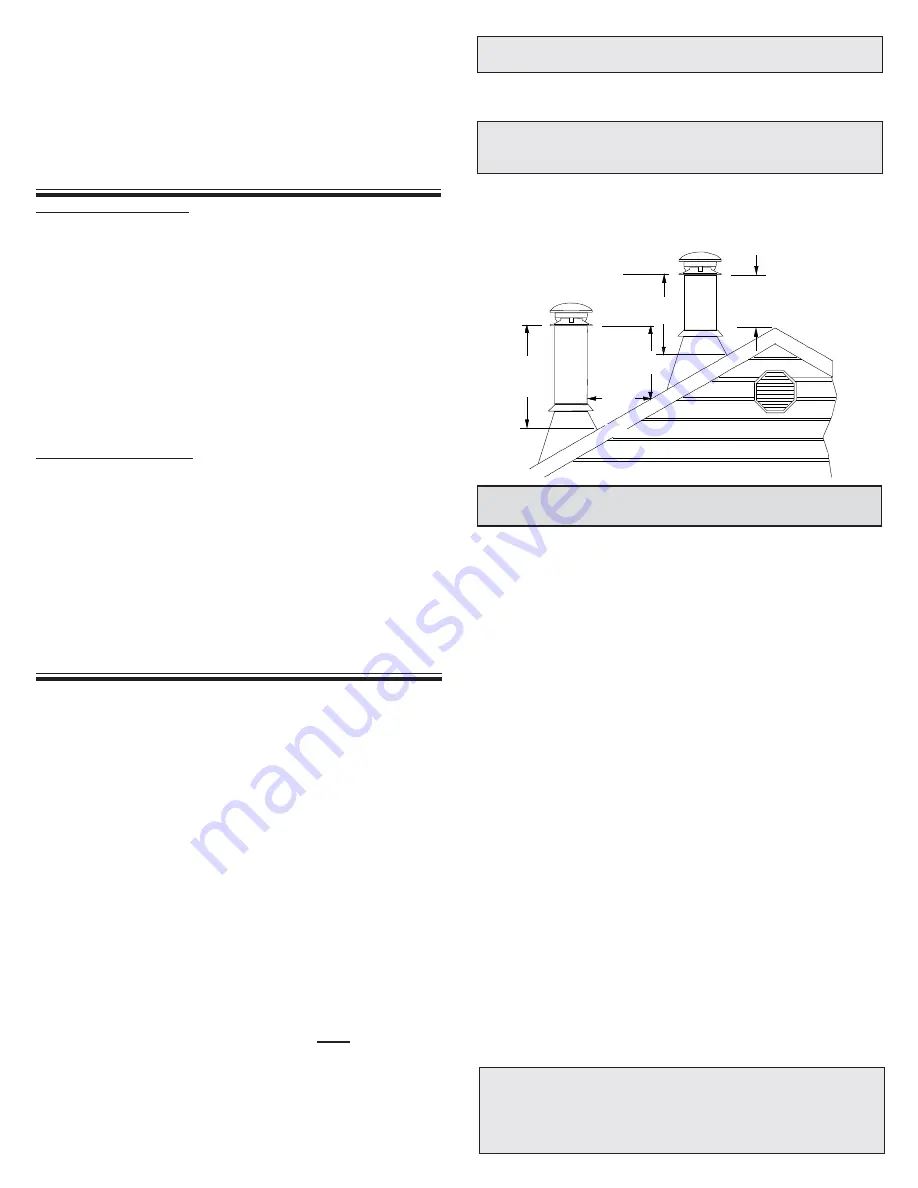
4
10 pds.
2 pds.
min.
3 pds.
min.
2 pds.
Authorities require that the chimney extend not less than 3 feet
(900 mm) above the highest point where it passes through the roof
of a building and not less than 2 feet (600 mm) above any portion
of the building within 10 feet (3 m). See figure 1 and Chart 2.
The ideal location for your chimney is within the building
envelope. In cold climates, the use of external chimneys may
result in operational problems such as poor draft, excessive
condensation of combustion products and rapid accumulation of
creosote. Under these circumstances, the installation of the
chimney within the building is strongly recommended.
If the chimney must be installed on an exterior wall it is
recommended that the chimney be enclosed below the roof line
to protect the chimney from cold outdoor temperatures, this may
help reduce condensation, creosote formation and enhance draft.
Provide an access door by the Tee Plug for chimney inspection
and cleaning. The exterior enclosure may be insulated, maintaining
the required minimum air space clearance of 2" (50mm) to any
part of the chimney. Consult local building codes for cold climate
applications.
Do not install the chimney directly at the outlet of the appliance.
Interconnecting smoke pipe is required unless the appliance is
specifically approved for that type of installation.
Use only with an appliance listed by a recognized testing
authority such as Underwriters Laboratories Inc., Underwriters
Laboratories of Canada, Intertek Testing Services, Warnock
Hersey or ICBO.
The flue diameter of gas or oil fired appliances should comply
with the appropriate Installation Codes such as CAN/CSA-B139
or CAN/CSA-B149 when installed in Canada, and the Installation
Codes NFPA 54, ANSI Z223.1 and NFPA 31 in the United States.
W
ARNING
: D
O
NOT
PLACE
ANY
INSULATING
MATERIALS
OR
RUN
ANY
ELECTRICAL
WIRING
WITHIN
THE
REQUIRED
AIR
CLEARANCE
SPACE
SURROUNDING
THE
CHIMNEY
.
M
AINTAIN
A
2"
MINIMUM
AIR
SPACE
CLEARANCE
BETWEEN
INSULATED
CHIMNEY
SECTIONS
AND
COMBUSTIBLE
MATERIALS
.
Your CF Sentinel chimney and connecting stove pipe diameter should
be sized in accordance with the appliance manufacturer’s
recommendations.
Plan the installation of your appliance and chimney in such a way that
both your chimney and your chimney connector (stovepipe) run is as
short and straight as possible. By having too long and / or multiple
bend installations you can reduce system draft which can affect the
operation, and or performance of your appliance and or the chimney
system. The chimney should be located within the building as to avoid
cutting or altering load bearing members such as joists, rafters, studs,
etc. If you have to cut or alter an existing load bearing member, special
reframing methods are required which often include doubling of
adjacent members. If such a case arises, contact your local Building
Code Official regarding local regulations and proper installation
methods.
Before commencing the installation ensure that you obtain any
necessary building permits, and that your installation will conform with
all federal and municipal building codes requirement.
Sections of the CF Sentinel chimney which pass through accessible
areas of the building such as through closets, storage areas, occupied
spaces or any place where the surface of the chimney could be
contacted by persons or combustible materials
must
be enclosed in
a chase. The chase may be fabricated using standard building
materials. Drywall mounted on 2” x 4” studs is typically used in this
situation. Except for installation in single and two family dwelling,
factory-built chimneys shall be enclosed with approved walls having
a fire resistance rating equal or greater than that of the floor or roof
assemblies through which they pass. The space between the outer
wall of the chimney and the enclosure shall be at least 2 inches.
TYPES OF APPLIANCES
PRE-INSTALLATION GUIDELINES
If you have a basic knowledge of carpentry and how to use hand
tools, taking on the task of installing your new venting system will
be easy. However, it is important that these installation instructions
are followed. If you choose to have your product professionally
installed, we recommend these products be installed by
professionals who are certified in Canada by WETT (Wood
Energy Technology Transfer) or l'APC (l'association des
professionels du chauffage) or NFI in the US.
Be sure that ladders are in good condition and always rest on a
level firm surface.
Be sure that electrically powered tools are properly grounded.
Y
OUR
CHIMNEY
HAS
BEEN
TESTED
,
AND
LISTED
USING
ALL
OF
THE
SUPPORTS
,
SHIELDS
,
ETC
.,
DESCRIBED
HEREIN
.
D
ELETION
OR
MODIFICATION
OF
ANY
OF
THE
REQUIRED
PARTS
OR
MATERIALS
MAY
SERIOUSLY
IMPAIR
THE
SAFETY
OF
YOUR
INSTALLATION
,
AND
VOID
THE
CERTIFICATION
AND
OR
WARRANTY
OF
THIS
CHIMNEY
.
FIGURE 1
3 ft.
min.
CANADA APPLICATIONS
Your CF Sentinel chimney has been tested per CAN/ULC-S629
as an all fuel chimney. As such it is code approved for connection
to solid, liquid or gas fueled residential type appliances and
building heating appliances in which the maximum continuous
flue gases temperatures do not exceed 650°C (1200°F). It has
also been tested and approved to withstand temperatures of up
to 2100°F for three thirty minutes intervals.
The installation should be in accordance with the Installation
Code CAN/CSA-B365 (Solid-Fuel-Burning Appliances and
Equipment) and / or the National Building Code of Canada and
Provincial Building Code, etc. should be consulted.
May also be used with specific factory-built fireplaces listed to
UL 127 and CAN/ULC-S610 when specified in the fireplace
manufacturer's installation instructions.
U.S.A. APPLICATIONS
The CF Sentinel chimney has been tested per UL-103 as "Type
HT". As such it is code approved for connection to solid, liquid
or gas fueled residential type appliances and building heating
appliances in which the maximum continuous flue gases
temperatures do not exceed 1000°F. It has also been tested and
approved to withstand temperatures of up to 2100°F for three ten
minutes intervals.
The installation should be in accordance with NFPA 211 (Standard
for Chimneys, Fireplaces, Vents and Solid Fuel fired Appliances),
and / or local and regional codes such as the International
Mechanical Code and Uniform Mechanical Code, etc.
W
EAR
SAFETY
GLOVES
WHEN
HANDLING
SHEET
METAL
PARTS
WITH
SHARP
EDGES
C
ONTACT
LOCAL
BUILDING
OR
FIRE
OFFICIALS
ABOUT
RESTRICTIONS
AND
INSTALLATION
INSPECTION
IN
YOUR
AREA
.
Summary of Contents for CF Sentinel
Page 3: ...3 CERTIFICATIONLABELS ...












